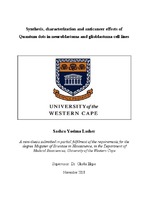| dc.description.abstract | Introduction: Nanoparticles (NPs) are gaining increased popularity for cancer treatment,
especially the multifunctional nanoparticles like Quantum dots (QDs) which have a wide range of
applications in nanotheranostics, cell imaging and targeted drug delivery to cancerous tissue. QDs
comprise of very tiny crystals of a semiconductor material (diameter: 2-10 nm) capable of
producing bright, intensive and size-tuneable near-infrared fluorescence emissions. In particular,
3-mercaptopropionic acid -capped Cadmium Telluride Quantum Dots with a zinc sulphide shell
(MPA-capped CdTe/ZnS QDs), are known to be very stable, highly photoluminescent, less toxic
with long-lasting “fluorophore” effects, thus making them the preferred QDs for this study.
Aims: To synthesize and characterize biocompatible MPA-capped CdTe/ZnS QDs to determine
size range, polydispersity index (PdI), zeta (ζ) potential, photoluminescence (PL) spectra, stability
in various milieus as well as to evaluate the effects of the synthesized QDs on the viability and
morphology of neuroblastoma (NB) and glioblastoma (GB) cell lines using the WST-1 cell
viability assay, imaging and cell cycle analysis.
Materials and methods: MPA-capped CdTe/ZnS QDs were synthesized and analysed with the
Zetasizer to determine ζ-potential, hydrodynamic (hd) size and PdI, while high resolutiontransmission
electron microscopy (HR-TEM) was used to validate the hd size and elemental
composition using energy dispersive X-ray (EDX) spectra. Pl absorption and emission spectra
were obtained with a fluorometer and stability studies were done using UV-Vis spectroscopy,
permitting further biological evaluation. A concentration range of 5-20μg/ml QDs was exposed to
U87 and SH-SY5Y cancer cell lines to determine biological effects at different time points, using
the WST-1 assay. Confocal fluorescence microscopy was used to establish uptake and cellular
localization of the QDs, cell morphology was visualized with an inverted microscope while cell
cycle distribution analysis was done using the C6 flow cytometer. | en_US |

